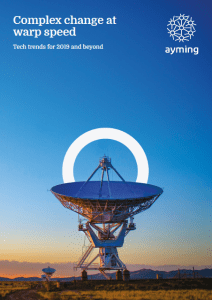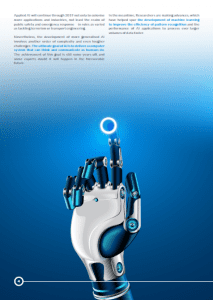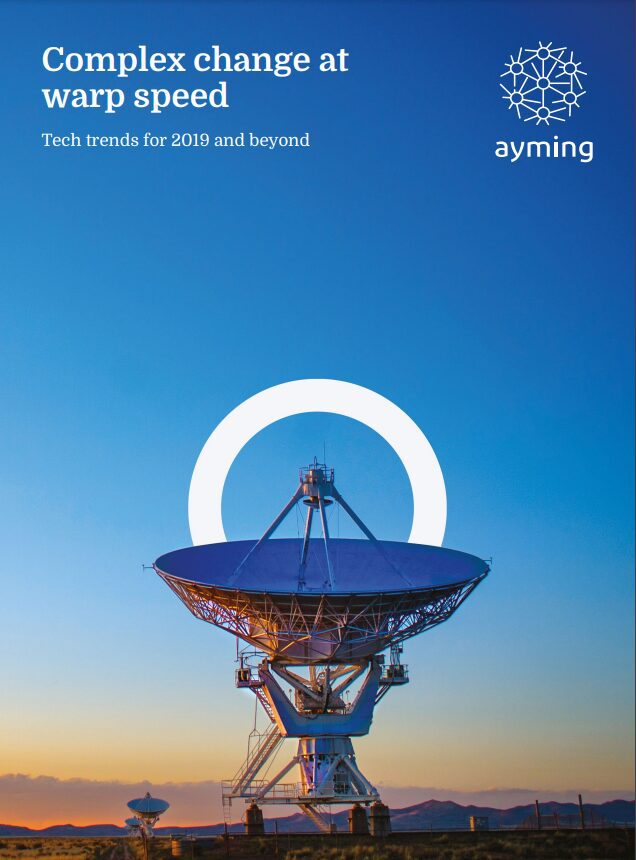
Table of contents
Executive summary
We’re not the first people to feel that technology is changing faster than ever. The impacts of inventions such as the motor car, TV, the PC, and mobile phones have undoubtedly prompted similar responses down the decades. Seen up close, the changes you witness loom large and seem all the more rapid for it.
However, we are living at a time of transition to a new era. The digital revolution has not only changed and disrupted many industries and aspects of our daily lives. It is enabling and impelling further waves of profound change and innovation all around us.
Some of the technologies that played a central role in enabling innovation have been reviewed below. Research indicates that the development of new capabilities using these technologies is set to accelerate in 2019 and beyond, as the tech superpowers and a teeming eco-system of start-ups vie to leap their technical barriers. These technologies too complement and depend on each other, reflecting what might be called ‘the interconnectedness of all things tech’.
The five trends
- Artificial intelligence
- Machine learning
- Internet of things
- Blockchain
- Cyber security
Artificial intelligence
Artificial intelligence (AI) is the branch of computer science that enables machines to perform activities that up to now have required human know-how, such as image or speech recognition.
Virtual assistants are probably the most familiar everyday manifestations of AI, and the big players in the AI field have their avatars: Siri (Apple), Alexa (Amazon), Google Assistant, Cortana (Microsoft).
However, the impact of applied AI is now being felt, particularly across sectors such as health sciences, where AI-driven solutions automate and improve the efficiency of complex processes for the early detection of certain cancers, and reduce the risks to patients in treatment programmes for those conditions.
Spending on cognitive and AI systems worldwide is expected to more than quadruple by 2021, according to International Data Corporation. That would see expenditure on these technologies grow from $12.0 billion in 2017 to a staggering $57.6 billion by 20211. Much of that spending is likely go to cloud-based AI services, outstripping investment in software and hardware.
Applied AI will continue through 2019 not only to colonise more applications and industries, not least the realm of public safety and emergency response – in roles as varied as tackling terrorism or transport engineering.
Nevertheless, the development of more generalised AI involves another order of complexity and even tougher challenges. The ultimate goal of AI is to deliver a computer system that can think and communicate as humans do. The achievement of this goal is still some years off, and some experts doubt it will happen in the foreseeable future.
In the meantime, Researchers are making advances, which have helped spur the development of machine learning to improve the efficiency of pattern recognition and the performance of AI applications to process ever-larger volumes of data faster.
Machine learning
Machine learning (ML) is a data analytics technology that endows computer systems with the ability to learn automatically and improve from experience without being explicitly programmed. ML’s growing role in artificial intelligence, the big advances being made in this field, and its take-up across industry make it worth considering as a highly significant tech trend in itself
Learning algorithms are central to the concept of ML. These algorithms build models that learn by processing a set of training data that contains many permutations of input and output data. Given this learning experience, the model can then predict a desired output accurately based on new or existing input data. ML algorithms may use supervised, unsupervised or reinforcement learning.
The capability of ML systems to recognise patterns or predict outcomes has a multitude of potential applications from gaming to engineering and the finance industry.
Computer gaming company NVidia is researching how deep learning can teach robots to work alongside and support humans. The aim is to enable robots to learn simply from observing a person carrying out tasks. Its main project is the ‘kitchen manipulator’.
In engineering, ML techniques are involved in developing computer vision applications for drones and delivery robots. The technology is also crucial for face recognition services that support payment authentication as well as picture-analysis bank verification and security systems.
Big software houses have seen the potential of ML to deliver business services, and they’re promoting and facilitating its adoption.
Google’s tensor processing units (TPUs) and Tensorflow Research Cloud provide enormous computing power, free of charge, to the machine learning research community ‘to support the next wave of breakthroughs’. Amazon has opened up its online training courses, offering the same curriculum used by its own engineers and scientists for free use. The courses cater for developers, data scientists, data platform engineers, and business people.
One of the challenges to mainstream adoption of ML is the quality and size of datasets available to effectively train ML models during the application development process. It seems like service providers are competing for leadership in the supply of training data for ML projects
According to business technology news website ZDNet2, Google and Facebook boast training datasets comprising, respectively, 9 million and 3.5 billion images.
Internet of things
The internet of things (IoT) is the portentous term for the network of devices able to connect and exchange data via the internet. This embraces home appliances, vehicles, and a host of items with electronics, sensors and actuators – and connectivity.
The IoT’s billing is likely to prove justified given this interconnectivity can support the delivery of innovative services such as remote monitoring of climate change or managing air pollution across smart cities – as well as having a multitude of more mundane uses, and applications that are probably now unimaginable.
Networking devices through IoT applications is providing a platform for delivering a new class of services. On the home front, this allows owners to turn the heating on while still on their journey back from work, and soon they may even choose from a list of recommended meals based on the stock of food in their refrigerators.
Many new and future applications of IoT will make our cities smarter with potentially immense benefit for the majority of the world’s population and the dense network of intensively used infrastructure and public services they rely on. Smart metering of water and energy is already a reality, which should promote more efficient use of these resources. Other applications would see the automation of transportation, water distribution and flood prediction, and surveillance systems – these are in prototype or being rolled out.
The IoT looks set to live up to the early hyperbole, as it extends to new uses, markets and industries. According to the business research analysts Gartner, by 2020 the total number of connected devices across all technologies will exceed 20 billion.
To support the expansion of the new technology, AWS (Amazon Web Services) provides a suite of IoT applications to secure connectivity between connected devices and cloud applications. This AWS IoT service is said to have the capacity to support billions of devices and trillions of messages, reliably and securely. In 2018, Microsoft launched the Azure Sphere, an end-to-end service for microcontroller-based devices, and Azure IoT Edge, which runs its IoT services and artificial intelligence on devices.
Nevertheless, there are obstacles to the relentless march of the IoT and its interconnected devices. One challenge is integrating devices made by different manufacturers. This is a complex process made more so in the absence of a generic standard for integration.
In the longer term, the sustained expansion of IoT applications will depend on new wireless networking technologies and innovation in silicon chip design. On this side of that horizon, questions of governance, ownership of data and privacy are looming larger. The need for a governance framework that sets minimal acceptable standards for those involved in the creation, storage, use and deletion of information related to IoT projects will become increasingly important as the IoT expands3.
Ethical concerns (and threats to privacy and security – see below) may prompt governments and regulatory authorities to impose constraints on the technology and its applications. But such is the potential economic and social value of the internet of things that the growth of this technology is likely to continue unfettered through 2019.
Blockchain
We have seen the highs and lows of cryptocurrencies like Bitcoin, but it is the blockchain technology that underpins this digital money that has emerged as one of the most bankable trends in tech.
Blockchain is a distributed ledger technology that creates a public ledger to record transactions between two parties in a secure and transparent way. The ‘blockchain’ of computers can only distribute rather than copy data so the network acts as a self-auditing ecosystem that reconciles each transaction. The information is held in blocks across several different servers and computers solve cryptographical puzzles to discover the next ‘block’ of information in the chain.
This decentralised peer-to-peer network operates in real time, bypassing the operational bureaucracy of financial institutions. The tech that gave birth to Bitcoin, and other cryptocurrencies, has obvious uses in the financial industry, but its implications go far wider.
UK start-up DADI (Decentralized Architecture for a Democratic Internet) is aiming to create a robust and secure alternative to the internet for delivering content via mobile applications and across websites on a network platform.
Start-ups and large enterprises are exploring the potential benefits of the technology across many other sectors. Cisco Systems, have invested in the infrastructure that will support the development of blockchain solutions. IBM also has its Hyperledger platform, while Ethereum, the open-source blockchain project, provides a platform for developers to build all kinds of decentralised applications. Blockchain is still an emerging technology. As a result, blockchain solutions are developed with different protocols, programming languages and platforms. This adds complexity when it comes to integrating blockchain applications with other technologies, such as the internet of things (IoT) and local or cloud-based systems.
The structural model of blockchain also relies on a complex transaction management process that hugs systems resources during execution. This can slow the completion time of transactions compared with existing systems.
Despite these challenges, the future is bright for blockchain. The potential uses for blockchain – from medical records to data management, and protecting our online identities to managing opinion polls or even elections – are mind- boggling.
The decentralised apps (Dapps) built with blockchain have the capacity to disrupt hundreds of industries. Given these possibilities and accelerating interest, we believe that more of these apps will gain traction in 2019 as this potentially far-reaching technology comes of age.
Cyber security
When it comes to IT investment, cloud computing is the top priority – ahead of artificial intelligence, data analytics and the internet of things – for many enterprises in 2019. And hard on its heels is the need to invest in cyber security.
Organisations are transferring their infrastructure and systems to the cloud to reduce costs. But concern about the security of customer data and other business-critical information and applications may become one of the main barriers to the on-going migration.
The phenomenal growth in computer systems, and their applications, means that businesses, governments, utility companies, transport networks and regulatory bodies, as well as individuals, are all heavily reliant on their IT systems. They are at risk from cyber threats, all the more so as out-dated regulations and compliance processes are outwitted by agile hackers and cybercriminals.
As more and more devices across the IT infrastructure of businesses and society at large are inter-connected, vulnerabilities to cyber-attack multiply. The consequences, even of non-criminal hacking, could be lethal; for example, if a self-driving car or heart pacemaker were compromised.
Traditional security risk management approaches to protecting IT infrastructure and data have been found wanting in a series of high-profile breaches. As a result, the established strategy of monitoring firewalls and endpoints is being supplemented or replaced by other preventative risk management techniques such as penetrative testing. A controlled form of hacking, this involves probing the vulnerabilities in applications and networks to identify and remedy weaknesses before cybercriminals can exploit them.
Cloud technology itself continues to evolve to address these threats as well as businesses’ operational problems and system infrastructure issues. So the cloud security field is ripe for further innovation to support and sustain this development.
Leading IT players – such as Cisco, Sophos, AWS (Amazon Web Services) and Microsoft Azure – are shifting the focus from provision of traditional security services to cloud security services. AWS and Azure have released certification programmes to encourage and support clients as they build the expertise to secure enterprise systems hosted on their cloud platforms.
The industry is also looking to leverage the capabilities of the other new and emerging technologies in the cause of more robust cyber security. Again, blockchain is a promising candidate.
As blockchain technology enables data to be stored across a decentralised network, it could prevent hackers from compromising large volumes of data. Blockchain also has the capability to filter system and network security activities in real time, and identify data that has been manipulated. As a result many specialists expect blockchain to become the cornerstone of cyber security in highly regulated industries, such as banking, if not across the board.
Some final thoughts
The pace of progress of these technologies, and society’s growing dependence on them, are raising the stakes and potential gains from innovation, which will continue driving investment and research in this sphere.
What’s more, the convergence and combination of new technologies spins off yet more innovation, so the impacts proliferate across many fronts like cyber security for example.
Machine learning and artificial intelligence are key allies in defence of cyber security. As mentioned, they are already being deployed in financial services for fraud prevention. AI and machine learning can automate detection and response to cyber threats, potentially filling this role far more efficiently than software-driven approaches.
That other disruptive technology, the internet of things, is adding further impetus to research and development into new approaches to cyber security. Prototypes of machine learning and AI applications have been designed to interpret the behaviour of devices – including IoT- connected devices – and detect abnormal use or behaviour on the network.
As technologies emerge and merge, they feed off each other, turbocharging the next generation of more powerful technology. This positive feedback loop underlies Ray Kurzweil’s Law of Accelerating Returns.
This foresees the gains in speed, efficiency, price- performance, and power accelerating exponentially. Potential returns to the successful tech developer are also significant attracting further resources in R&D investment and human talent, fuelling the cycle of invention. So, Kurzweil would argue, that as barriers are encountered, technological leaps will overcome them, sustaining this exponential acceleration.


Ajibola Majekodunmi
Assistant Manager, R&D Incentives
Aji joined Ayming in 2018 and he is an experienced IT professional with a Master’s degree in Software Project Management. Aji is a thought leader for technology in the Innovation team, specialising in delivering IT claim projects for SMEs and Large Companies.
1https://www.idc.com/getdoc.jsp?containerId=prUS43095417
2https://www.zdnet.com/article/what-is-machine-learning-everything-you-need-to-know/
3https://mitechnews.com/internet-of-things/gartner-report-internet-of-things-top-tech-trends-through-2023/









